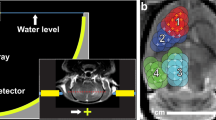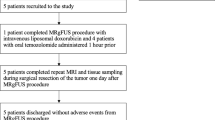Abstract
Low-frequency ultrasound (LFU) irradiation under certain acoustic intensity can increase blood–brain barrier permeability non-invasively and reversibly. The aim of this study was to find out the effect of LFU irradiation on blood–tumor barrier (BTB) permeability in rat C6 glioma model and the possible mechanism. In this research, Evans blue and H&E staining were used to evaluate the optimal parameter of LFU to open the BTB without damaging the normal brain tissue. Transmission electron microscopy was used to observe the changes of the number of pinocytotic vesicles in cerebral or glioma microvascular endothelial cells. The phosphorylation of tyrosine kinase Src, caveolin-1, and caveolin-2 was detected by western blot. The distribution and expressing levels of caveolae proteins, caveolin-1 and caveolin-2, were detected by immunohistochemical and immunofluorescent staining, RT-PCR, and western blot. Our research data showed that, in rat C6 glioma model, LFU irradiation at a frequency of 1 MHz, a power of 12 mW, and exposure time of 20 s induced the increase of BTB permeability temporally, which reached a peak at 1.5 h, then decreased and restored to normal level at 12 h after LFU irradiation. In the glioma microvascular endothelial cells of rat glioma model, LFU irradiation induced a significant increase of the pinocytotic vesicles’ density. The phosphorylation of Src, caveolin-1, and caveolin-2 began to increase at 0.5 h and reached a maximum at 1 h. Immunohistochemical and immunofluorescent staining showed that caveolin-1 and caveolin-2 were co-localized in the glioma microvascular endothelial cells and glioma cells. The mRNA and protein expression levels of caveolin-1 and caveolin-2 were up-regulated, reached the peak value at 1.5 h, and re-normalized at 12 h after LFU irradiation. These results demonstrated that LFU irradiation increased BTB permeability by promoting transcellular transport in glioma microvascular endothelial cells. The phosphorylation of tyrosine kinase Src, caveolin-1, caveolin-2 and up-regulation of caveolin-1 and caveolin-2 were involved in LFU-induced caveolae-mediated endocytosis.







Similar content being viewed by others
References
Anderson RG, Kamen BA, Rothberg KG et al (1992) Potocytosis: sequestration and transport of small molecules by caveolae. Science 255(5043):410–411
Aoki T, Nomura R, Fujimoto T (1999) Tyrosine phosphorylation of caveolin-1 in the endothelium. Exp Cell Res 253(2):629–636
Daffertshofer M, Gass A, Ringleb P (2005) Transcranial low-frequency ultrasound-mediated thrombolysis in brain ischemia: increased risk of hemorrhage with combined ultrasound and tissue plasminogen activator: results of a phase II clinical trial. Stroke 36:1441–1446
Dannold N, Vykhodtseva N, Hynynen K (2007) Use of ultrasound pulses combined with Definity for targeted blood–brain barrier disruption: a feasibility study. Ultrasound Med Biol 33(4):584–590
Fan L, Liu Y, Ying H, Xue Y, Zhang Z, Wang P, Liu L, Zhang H (2011) Increasing of blood–tumor barrier permeability through paracellular pathway by low-frequency ultrasound irradiation in vitro. J Mol Neurosci 43(3):541–548
Gumbleton M (2001) Caveolae as potential macromolecule trafficking compartments within alveolar epithelium. Adv Drug Deliv Rev 49(3):281–300
Gumbleton M, Abulrob AG, Campbell L (2000) Caveolae: an alternative membrane transport compartment. Pharm Res 17(9):1035–1048
Gumbleton M, Hollins AJ, Omidi Y et al (2003) Targeting caveolae for vesicular drug transport. J Control Release 87(1–3):139–151
Hu J, Yuan X, Ko MK et al (2007) Calcium-activated potassium channels mediated blood–brain tumor barrier opening in a rat metastatic brain tumor model. Mol Cancer 14(6):22
Hynynen K, McDannold N, Martin H et al (2003) The threshold for brain damage in rabbits induced by bursts of ultrasound in the presence of an ultrasound contrast agent (Optison). Ultrasound Med Biol 29(3):473–481
Hynynen K, McDannold N, Sheikov NA et al (2005) Local and reversible blood–brain barrier disruption by noninvasive focused ultrasound at frequencies suitable for trans-skull sonications. NeuroImage 24(1):12–20
Hynynen K, McDannold N, Martin H et al (2006) Focal disruption of the blood–brain barrier due to 260-kHz ultrasound bursts: a method for molecular imaging and targeted drug delivery. J Neurosurg 105(3):445–454
Jalali S, Huang Y, Dumont DJ et al (2010) Focused ultrasound-mediated BBB disruption is associated with an increase in activation of AKT: experimental study in rats. BMC Neurol 10:114
Jolliet-Riant, Tillenment JP (1999) Drug transfer across the blood–brain barrier and improvement of brain delivery. Fundam Clin Pharmacol 13(1):16–26
Lee H, Park DS, Wang XB, Scherer PE, Schwartz PE, Lisanti MP (2002) Src-induced phosphorylation of caveolin-2 on tyrosine 19. Phospho-caveolin-2 (Tyr(P)19) is localized near focal adhesions, remains associated with lipid rafts/caveolae, but no longer forms a high molecular mass hetero-oligomer with caveolin-1. J Biol Chem 277(37):34556–34567
Lionetti V, Fittipaldi A, Agostini S et al (2009) Enhanced caveolae-mediated endocytosis by diagnostic ultrasound in vitro. Ultrasound Med Biol 35(1):136–143
McDannold N, Vykhodtseva N, Hynynen K (2006) Targeted disruption of the blood–brain barrier with focused ultrasound: association with cavitation activity. Phys Med Biol 51(4):793–807
Pardridge WM (2007) Blood–brain barrier delivery. Drug Discov Today 12(1–2):54–61
Reinhard M, Hetzel A, Krüger S et al (2006) Blood–brain barrier disruption by low-frequency ultrasound. Stroke 37(6):1546–1568
Schneider F, Gerriets T, Walberer M et al (2006) Brain edema and intracerebral necrosis caused by transcranial low-frequency 20-kHz ultrasound: a safety study in rats. Stroke 37(5):1301–1306
Schnitzer JE (2001) Caveolae: from basic trafficking mechanisms to targeting transcytosis for tissue-specific drug and gene delivery in vivo. Adv Drug Deliv Rev 49(3):265–280
Shajahan AN, Tiruppathi C, Smrcka AV, Malik AB, Minshall RD (2004) Gbetagamma activation of Src induces caveolae-mediated endocytosis in endothelial cells. J Biol Chem 279(46):48055–48062
Sheikov N, McDannold N, Sharma S et al (2008) Effect of focused ultrasound applied with an ultrasound contrast agent on the tight junctional integrity of the brain microvascular endothelium. Ultrasound Med Biol 34(7):1093–1104
Wang JE, Liu YH, Liu LB et al (2011) Effects of combining low frequency ultrasound irradiation with papaverine on the permeability of the blood–tumor barrier. J Neurooncol 102(2):213–224
Williams TM, Lisanti MP (2004) The caveolin proteins. Genome Biol 5(3):214
Xia CY, Zhang Z, Xue YX et al (2009) Mechanisms of the increase in the permeability of the blood–tumor barrier obtained by combining low-frequency ultrasound irradiation with small-dose bradykinin. J Neurooncol 94(1):41–50
Zhang Z, Xia CY, Xue YX et al (2009) Synergistic effect of low-frequency ultrasound and low-dose bradykinin on increasing permeability of the blood–tumor barrier by opening tight junction. J Neurosci Res 87(10):2282–2289
Acknowledgment
This work is supported by grants from the Natural Science Foundation of China (nos. 30670723, 30872656, 30973079, 81001029, and 81072056), the special fund for Scientific Research of Doctor-Degree Subjects in Colleges and Universities (nos. 20092104110015 and 20102104110009), and Shenyang Science and Technology Plan Projects (nos. F-10-205-1-22 and F-10-205-1-37).
Author information
Authors and Affiliations
Corresponding author
Additional information
Chun-yi Xia and Yun-hui Liu contributed equally to this work.
Rights and permissions
About this article
Cite this article
Xia, Cy., Liu, Yh., Wang, P. et al. Low-Frequency Ultrasound Irradiation Increases Blood–Tumor Barrier Permeability by Transcellular Pathway in a Rat Glioma Model. J Mol Neurosci 48, 281–290 (2012). https://doi.org/10.1007/s12031-012-9770-0
Received:
Accepted:
Published:
Issue Date:
DOI: https://doi.org/10.1007/s12031-012-9770-0




